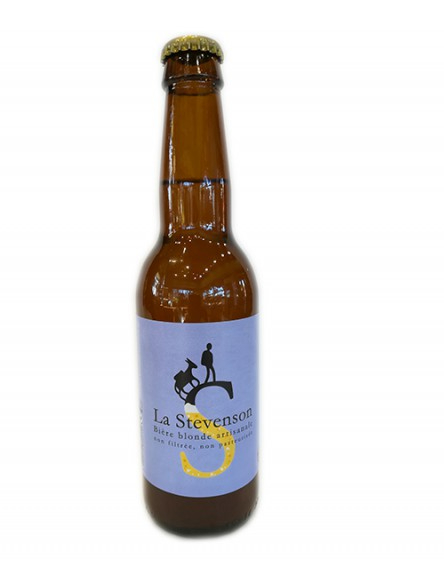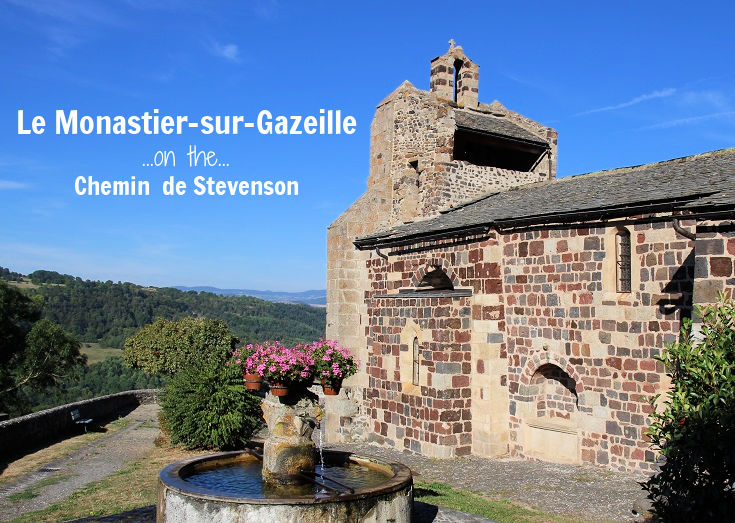* * * *
* * * *
May 21, 2024 – It’s been quite the adventure so far. Talking about getting to Paris for that September 2023 hike in France, then my going on to Lyon and finally down to Le Puy en Velay. That’s where my brother, his wife and I started our 150-mile hike on the Stevenson Trail. (GR 70.) From there the adventures continued: A night without beer or even wine in Monistair, closed down tight for Sunday night. On to Bargettes, then to “Camping Above the Clouds,” with its wide-open freedom-spaces. And finally making it to just east of Langogne for our first day off, after four days’ shakedown hiking. (To be followed by six straight days of hiking.)
Then there was the glitch – covered in the last post – of “losing” my 2023 journal. It had lots of descriptive-detail notes, but I didn’t find it until last May 7. But the long and the short of the hike so far – for me anyway – was I hadn’t had a cold beer – at night – since leaving Le Puy. (Despite defining a Camino hike as, “At the end of each day you look forward to a warm bed, hot shower and a cold beer.”) Then the place east of Langogne turned out to be the Promised Land.
But first we had to get there.
As the last post said, we got to Langogne in good time and hiked through mid-town, then on down Avenue du Gevaudan. Past the southern outskirts and on a bit until we finally realized, “We’re going the wrong way!” Then back to the middle of town, stopping for supplies including a heavy bottle of wine for the night. (For at least two of us.) Langogne was and is full of nice warm places to stay, but we left it all behind to head into a seemingly deserted countryside in the fading daylight. (My thought, “Will we end up sleeping under the stars, out in the country air?”) But we found the lodging, a 40-minute hike east of town, and it was worth the wait.
The destination was actually a cute little hamlet, Brugeyrolles, a mile and a half east of Langogne. A “Gite,” rental apartment. Not MUCH of a hamlet, but there’s a cafe bar right across the lane… And the nice lady owner said she served beer! (I’ve had more than my share of beerless nights, though wine will do in a pinch.)
I didn’t get a beer that night – we had that big heavy bottle of wine – but I did the next night. (And it was great!) But first, about that “Chambres d’hotes, Gite d’etape.”
It’s a big stone building – stone floor, stone walls – with two stories and separate bedrooms upstairs, for Tom and I, along with a full bathroom. Carol opted to take the couch downstairs, in the kitchen-dining-room area, and not for the last time on the hike. (She seemed to like being close to the kitchen.) Dinner in our lodging was subdued that night; we were tired. But there was that promise of sleeping late, and maybe a hike back into town – without packs. Then a nice relaxing afternoon, and even a beer or two at dinner tomorrow night. I felt in heaven…
Next morning Tom and I hiked back the 40 minutes to Langogne, to sightsee a bit and get necessaries for the six straight days hiking coming up. On the way in we saw the cute couple with their own rented “Modestine,” hiking a la Robert Louis Stevenson. It was indeed “cute” but I didn’t envy having to groom and feed the critter, not to mention the added expense.
As we say back in Georgia, “Bless their hearts!”
After a light lunch I spent the afternoon curled up in a cozy bed. “At 3:35 this afternoon laying in bed with a comforter against the chill.” The weather so far was much colder than expected and not at all like our earlier Camino hikes. (Stevenson himself went through really cold weather, plus rain, high wind and hale, all while having to camp out many nights in only that 6-by-6-foot sleeping bag.) Anyway, in that cozy bed under the thick comforter – nice and warm – I sipped hot tea, read Kindle books on my tablet, took some notes and pondered the hike so far. One note: “So far little resemblance to RLS’s travels with Modestine.”
Another thought that afternoon, snuggling in the comforter against the chill. “The pack. It weighs you down on the Trail. Holding all your worldly goods for a month in a strange land. All strapped to your back. Then when needed – or when you settle in – it lifts you up. Like when you need to break out the heavy but solid yellow rubber rain jacket.” Among other benefits, that big yellow rain jacket provided a surprising amount of warmth.
And about eating in France: “You eat what you can, when you can. Like yesterday’s three-course lunch in Pradelles. Way too much food! But at the store yesterday afternoon – on the way here – I got a small pre-made packaged salad. That and some wine did me for the night.” Then after a bit of yoga on the stone-cold floor – with the comforter as a yoga mat – I got back in bed. “I’m shifting between laying full down and reading the tablet, or half-sitting up propped by the pillow, or full sitting up in bed as I am now. (Do I hear Tom snoring in the second-floor room down the hall? Carol insisted on the couch downstairs in the kitchen area just by the entrance.”
Then at 4:26 p.m., “after a bathroom break and some more yoga, I read more of Three Months in the Southern States, a PDF file on my tablet.” (Meaning I don’t need internet to read it.) That was an interesting read, there in rural France, written by Captain Arthur Fremantle of the Coldstream Guards, “upon his return to England from his three-month stay” in the Confederate States in the middle of 1863. Talk about an adventure…
And a definite distraction from being 72 years old and about to start hiking the rugged Cévennes Mountains in south-central France. (On the “south-east edge of the Massif Central.”) For another distraction I checked out the place, Les Cremades, One sample: “Everyone needs a place to lay their weary head. For travellers visiting Langogne, Les Cremades is an excellent choice for rest and rejuvenation.” And to that, “I couldn’t agree more.”
Another source of rejuvenation was the chance to finally get a beer at the end of the day. So we crossed the dirt lane to another big stone building, for what turned out to be a dinner with four other hikers, plus the hostess. (The nice lady owner from the night before who said she offered cold beer.) And I was jonesing for a rewarding, day’s-end cold beer.
Entering the lobby I saw there was quite a selection. I chose a Bière La Stevenson (shown below), which seemed highly appropriate. Which brings up the wonderful communal dinner we shared that night. A long, wooden-slat table covered with plastic sheeting. I sit at one end, Carol at my left, the hostess standing to my right, Tom at the other end taking a picture. One “mature” lady hiker to the right of the hostess, with two more sitting on the other side. All three mostly spoke French, and between the two on the other side sat a blonde young man, wearing glasses and sporting hair down to his collar. He spoke fluent French and English, which seemed to happen a lot at those shared dinners that came up later. (“The Camino Will Provide.”)
I don’t remember much about the conversation that night, except that it was pleasant and charming. (With the young man interpreting French to “American” and back again.) And that I only had that one beer before I switched to sharing the two large bottles of wine the nice-lady hostess provided. Which may explain how I wrote in my journal later that night:
“A most enjoyable evening [I think I wrote] across the lane. 4 other hikers. I forgot my tablet [indecipherable]. 4 courses including fromage and coffee at the end. One beer, two types of wine. I’ll be interested to see how this [handwriting] looks in the morning.”
From the looks of that handwriting I think I had a really good time. But I was in France, the real France, away from big cities and among the the salt of the earth, including four fellow Stevenson Trail hikers. (“Clearly called to influence, improve and make the world a better place.”) And besides, in the morning we’d be starting six straight days of hiking…
* * * *

* * * *
I took the upper photo. I originally FB-posted this caption: “Greetings from Langogne! After four days, a day off from hiking. Our place is east of town. Hiking back in – sans pack – we saw this cute couple doing the REAL Chemin Stevenson thing. Thus the donkey…” And speaking of a first day off, “no hiking,” I define walking as not carrying a 20-pound pack. See also Walking – Wikipedia, on “one of the main gaits of terrestrial locomotion among legged animals.” Then there’s “rucking,” as in A Beginner’s Guide to Rucking – Verywell Fit. “Rucking involves walking or hiking with a weighted backpack and is an exciting way to combine strength, endurance, and the great outdoors.”
“The Camino Will Provide.” In this case referring to the 2011 book by David O’Brien: “Learning To Trust the Universe is one man’s journey of body, mind and spirit. The adventure begins with a valiant leap of faith, as the author, David O’Brien, heeds the final words of a dear friend ‘Follow your heart… life is brief’ and embarks on a 500-mile walking pilgrimage across Spain.” (From St. Jean Pied de Port to Santiago, not the mere 450 miles from Pamplona.) But we three knew the saying beforehand. (Perhaps as a variation of “The Lord will provide,” spoken by Abraham in Genesis 22:14.)
On mixing beer and wine. Apparently it’s not as bad as some of those old wive’s tales say. See Is Mixing Alcohol Bad? RDs Explain the Wine Before Liquor, and Can You Mix Beer and Wine: Guide to Compatibility. Then there’s that line in the film Midnight in Paris where Scott Fitzgerald tells Ernest Hemingway that he’s been “mixing grape and grava,” or what sounds like “grava.” But I haven’t been able to find any word like that for beer…
Re: Salt of the earth. See What Does “Salt of the Earth” Mean in Matthew 5:13?
The lower image is courtesy of Bière blonde artisanale La Stevenson : vente en ligne.
* * * *





